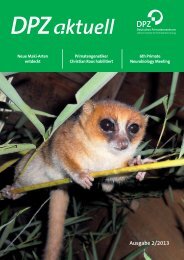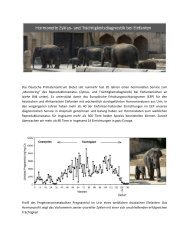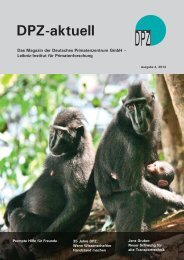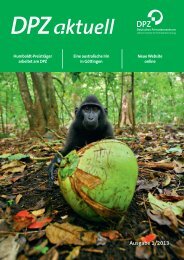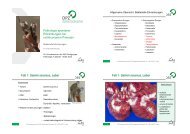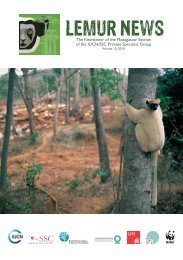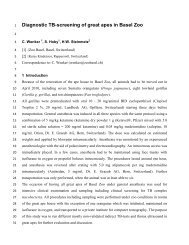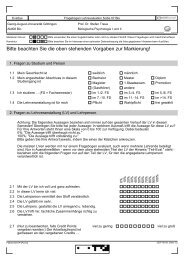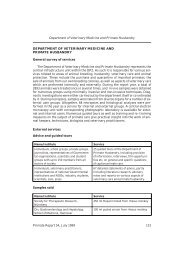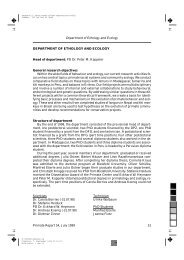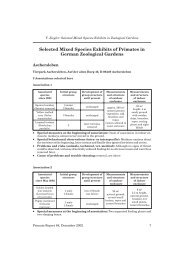Final Remarks Acknowledgement Appendix: Index of ... - DPZ
Final Remarks Acknowledgement Appendix: Index of ... - DPZ
Final Remarks Acknowledgement Appendix: Index of ... - DPZ
Create successful ePaper yourself
Turn your PDF publications into a flip-book with our unique Google optimized e-Paper software.
<strong>Final</strong> remarks<br />
T. Ziegler: Selected Mixed Species Exhibits in Zoological Gardens<br />
According to the experiences made in this study, the advantages and disadvantages<br />
<strong>of</strong> mixed species exhibits in zoos are as different as the enclosure qualities and<br />
the species involved. As a general rule, it can be stated that problems in associating<br />
different species are inversely proportional to the size and structural enrichment <strong>of</strong><br />
the enclosure: the larger and the more naturally enriched the enclosure, the fewer<br />
the problems. To prevent competitive situations within the enclosure, one should<br />
avoid combining animals that occupy the same ecological niche. Therefore combinations<br />
<strong>of</strong> aquatic, semi-aquatic, terrestrial and arboreal species can be recommended,<br />
as they would occupy different sections <strong>of</strong> the enclosure. As long as associated species<br />
have exclusive access to certain sections <strong>of</strong> the enclosure (resting rooms or<br />
boxes), combinations <strong>of</strong> diurnal, nocturnal and cathemeral animals can also be helpful<br />
in creating non-competitive situations.<br />
For behavioural, practical and educational reasons, the species for a mixed exhibit,<br />
should generally be selected according to the models found in the respective<br />
natural habitats. Although such a selection is <strong>of</strong>ten helpful in preventing major<br />
problems, it can not exclude some unexpected difficulties, as the success <strong>of</strong> a mixed<br />
exhibit does not only depend on the selected species, but also on their group structure<br />
and individual characters <strong>of</strong> the animals involved. That’s why even among<br />
Callitrichids e.g., which are well known for forming a variety <strong>of</strong> stable polyspecific<br />
associations in the wild (HEYMANN and BUCHANAN-SMITH, 2000), a successful<br />
combination in captivity can not always be taken for granted. On the other hand,<br />
sloths seem to be compatible with a vast variety <strong>of</strong> other species and even a combination<br />
between primates and potential predators (e.g. rhesus monkeys and sloth bears:<br />
see Zoo Leipzig) can prove workable. Thus, the establishment <strong>of</strong> polyspecific associations<br />
in captivity will always be a matter <strong>of</strong> trial and error to a certain amount and<br />
the initial phases as well as periods <strong>of</strong> demographic changes have to be intensively<br />
monitored.<br />
Once an association is successfully established, it will not only be an enrichment<br />
for the animals involved, but also for the zoo visitors and thus for the zoo itself. The<br />
attraction <strong>of</strong> mixed species exhibits for visitors is not only documented by their positive<br />
comments, anecdotally cited by keepers, but it can also be measured quantitatively.<br />
The mixed species exhibits e.g. in the zoos <strong>of</strong> Landau (SEIBOLD et al., 2002)<br />
and Beekse Bergen (DELEU, pers. com.) are reported to motivate visitors to linger<br />
for longer periods <strong>of</strong> time and to observe the animals and their interactions more<br />
closely. In some cases, newly established mixed species exhibits are even the main<br />
reason for visitors to come, as they have heard about this attraction from other people<br />
or from reports in the media. This way, mixed species exhibits, zoologically and<br />
environmentally adapted to natural habitats, can have a considerable educational<br />
value for the public and they can be helpful in gaining support for in situ conservation<br />
measures for the species presented.<br />
As the numerous advantages <strong>of</strong> successfully established mixed species exhibits<br />
by far outweigh their potential problems and risks, this concept <strong>of</strong> keeping and presenting<br />
(<strong>of</strong>ten endangered) animals should be followed up in a cooperative manner<br />
between zoos, by exchanging their experiences and expertise.<br />
Primate Report 64, December 2002 85
T. Ziegler: Selected Mixed Species Exhibits in Zoological Gardens<br />
<strong>Acknowledgement</strong><br />
The author would like to thank all the Zoo Directors, Curators and Keepers,<br />
which contributed data to this study and invested time and effort to transmit all the<br />
information needed, to make this publication possible.<br />
<strong>Appendix</strong>: <strong>Index</strong> <strong>of</strong> Primates in Mixed Species Exhibits<br />
Species Zoo<br />
Alouatta seniculus Köln<br />
Aotus azarae Braunschweig, Frankfurt, Gettorf<br />
Aotus trivirgatus Dortmund<br />
Ateles ge<strong>of</strong>froyi Frankfurt, Karlsruhe<br />
Cacajao calvus calvus Köln<br />
Cacajao calvus rubicundus Köln<br />
Cacajao melanocephalus Köln<br />
Callicebus moloch Köln<br />
Callimico goeldii Dortmund, Halle, Karlsruhe,<br />
Köln, Münster<br />
Callithrix ge<strong>of</strong>froyi Dresden, Frankfurt, Heidelberg,<br />
Köln, Münster<br />
Callithrix jacchus Braunschweig, Düsseldorf, Halle,<br />
Heidelberg, Rostock, Schwerin<br />
Callithrix penicillata Dresden, Gettorf<br />
Callithrix pygmaea Aschersleben, Eberswalde, Frankfurt,<br />
Gettorf, Heidelberg, Köln<br />
Cebuella see Callithrix<br />
Cebus apella Hodenhagen, Rostock<br />
Cercocebus patas see Erythrocebus<br />
Cercopithecus petaurista Rostock<br />
Chiropotes sp. x sp. Köln<br />
Chlorocebus aethiops Hodenhagen<br />
Colobus guereza Hodenhagen<br />
Erythrocebus patas Rostock<br />
Eulemur fulvus albifrons Hodenhagen<br />
Eulemur fulvus rufus Hannover<br />
Galago moholi Frankfurt<br />
Gorilla gorilla gorilla Heidelberg<br />
Hylobates [nomascus] gabriellae Leipzig<br />
Lemur catta Frankfurt, Hodenhagen, Karlsruhe<br />
Leontopithecus chrysomelas Aschersleben, Gettorf, Köln, Münster,<br />
Osnabrück, Stuttgart<br />
Leontopithecus chrysopygus Magdeburg<br />
Leontopithecus rosalia Eberswalde, Frankfurt, Köln, Krefeld,<br />
Landau<br />
Macaca fuscata Berlin<br />
Macaca mulatta Berlin, Leipzig<br />
86 Primate Report 64, December 2002
Species Zoo<br />
Macaca silenus Münster, Rostock<br />
Macaca sylvanus Hodenhagen<br />
Mandrillus sphinx Dresden, Halle<br />
Microcebus rufus Landau<br />
Papio hamadryas anubis Hodenhagen<br />
Papio hamadryas hamadryas Beekse Bergen, Hodenhagen, München<br />
Pithecia pithecia Frankfurt, Gettorf, Köln, Krefeld,<br />
Magdeburg, Stuttgart<br />
Pongo abelii Leipzig<br />
Pongo pygmaeus Münster<br />
Presbytis entellus see Semnopithecus<br />
Semnopithecus entellus Hannover, Hodenhagen<br />
Saguinus fuscicollis Halle, Hannover, Köln<br />
Saguinus imperator Gettorf, Osnabrück<br />
Saginus labiatus Dresden, Frankfurt, Gettorf, Halle,<br />
Magdeburg<br />
Saguinus midas Gettorf, Köln, Magdeburg<br />
Saguinus nigricollis Rostock<br />
Saguinus oedipus Aschersleben, Braunschweig,<br />
Hannover, Osnabrück, Rostock<br />
Saimiri boliviensis Frankfurt, Heidelberg<br />
Saimiri sciureus Aschersleben, Halle, Hannover,<br />
Hodenhagen, Landau<br />
Theropithecus gelada Rheine, Stuttgart<br />
Varecia variegata rubra Frankfurt<br />
References<br />
T. Ziegler: Selected Mixed Species Exhibits in Zoological Gardens<br />
ASPER, M., HOFMANN, P., OSMANN, C., FUNK, J., METZGER, C., BRUNS, M.,<br />
KAUP, F.-J., SCHMITZ, H., GÜNTHER, S.: First outbreak <strong>of</strong> Callitrichid hepatitis<br />
in Germany: Genetic characterization <strong>of</strong> the causative lymphocytic choriomenengitis<br />
virus strains. Virology (2001) 284: 203-213.<br />
BARTMANN, W.: Keeping and breeding a mixed group <strong>of</strong> large South American<br />
mammals at Dortmund Zoo. International Zoo Yearbook (1980) 20: 271-274.<br />
BARTMANN, W.: Interactions among South American animals. IUDZG, Scientific<br />
session <strong>of</strong> the 45th annual conference August 26-30, 1990, Copenhagen, DK.<br />
BERTRAM, B.C.: Living in groups. In: KREBS, J.R., DAVIS, N.B. (eds.): Behavioural<br />
Ecology. Sunderland, MA, Sinauer Associates (1978): 64-96.<br />
BUCHANAN-SMITH, H.M.: Polyspecific associations <strong>of</strong> two tamarin species, Saguinus<br />
labiatus and Saguinus fuscicollis, in Bolivia. American Journal <strong>of</strong> Primatology<br />
22 (1990): 205-214.<br />
Primate Report 64, December 2002 87
T. Ziegler: Selected Mixed Species Exhibits in Zoological Gardens<br />
DELEU, R., VEENHUIZEN, R. and NELISSEN, M.: Evaluation <strong>of</strong> the Mixedspecies<br />
exhibit <strong>of</strong> African elephants and hamadryas baboons in Safari Beekse<br />
Bergen, The Netherlands. Primate Report (2003) 65: 5-19.<br />
EEP, Research and Captive Propagation, Research Committee Newsletter, 7th Issue,<br />
August 2000.<br />
GADDIS, P.: Mixed flocks, accipiters and anti-predator behavior. Condor (1980) 82:<br />
348-349.<br />
GAUTIER-HION, A.: Polyspecific associations among forest guenons: ecological, behavioural<br />
and evolutionary aspects. In: GAUTIER-HION, A., BOURLIERE, F.,<br />
GAUTIER, J.-P., KINGDON, J. (eds.): A Primate Radiation. Evolutionary Biology <strong>of</strong><br />
the African Guenons.Cambridge University Press (1988): 452-476.<br />
HAMMER, G.: Gemeinschaftshaltungen verschiedener Säugetierarten in Zoos. Dissertation<br />
an der Naturwissenschaftlichen Fakultät der Universität Salzburg, 2001.<br />
Available on CD-ROM via the author: icepack@web.de or Internet: www.ethologie.at.tf.<br />
HEYMANN, E.W.: Interspecific relations in a mixed species troop <strong>of</strong> Moustached<br />
tamarins, Saguinus mystax, and Saddle-back tamarins, Saguinus fuscicollis (Platyrrhini:<br />
Callitrichidae), at the Rio Blanco, Peruvian Amazonia. American Journal<br />
<strong>of</strong> Primatology (1990) 21: 115-127.<br />
HEYMANN, E.W., SICCHAR L.V., TAPIA, J.R.: Experiences with mixed species<br />
housing <strong>of</strong> Tamarins, Saguinus fuscicollis and Saguinus mystax (Primates: Callitrichidae)<br />
in an outdoor enclosure. Zool. Garten N. F. (1996) 66-6: 381-390.<br />
HEYMANN, E.W., Buchanan-Smith, H.M.: The behavioural ecology <strong>of</strong> mixed-species<br />
troops <strong>of</strong> callitrichine primates. Biol. Rev. (2000) 75: 169-190.<br />
KAUMANNS, W., KREBS, E., SCHWITZER, C.: Primatenhaltung im Kölner Zoo,<br />
Zeitschrift des Kölner Zoos 3, (2002) 45: 103-116.<br />
KURUP, G.U., KUMAR, A.: Time budgets and activity patterns <strong>of</strong> the lion-tailed<br />
macaque (Macaca silenus). American Journal <strong>of</strong> Primatology (1993)14 (1): 27-39.<br />
MORSE, D.H.: Ecological aspects <strong>of</strong> some mixed-species foraging flocks <strong>of</strong> birds. Ecological<br />
Monographs (1970) 40: 119-168.<br />
MUNN, C.A.: Birds that "cry wolf". Nature (1986) 319: 143-145.<br />
POOK, A.G., POOK, G.: Polyspecific association between Saguinus fuscicollis,<br />
Saguinus labiatus, Callimico goeldii and other primates in north-western Bolivia.<br />
Folia Primatologia (1982) 38: 196-216.<br />
POWELL, G.V.N.: Sociobiology and adaptive significance <strong>of</strong> interspecific foraging<br />
flocks in the Neotropics. In: BUCKLEY, P.A., FOSTER, M.S., MORTON, E.S.,<br />
88 Primate Report 64, December 2002
T. Ziegler: Selected Mixed Species Exhibits in Zoological Gardens<br />
RIDGELY, R.S., BUCKLEY, F.G. (eds.): Neotropical Ornithology. Ornithological<br />
Monographs (1985) 36: 713-732.<br />
SALZERT, W., JOHANN, A.: Maintenance <strong>of</strong> the Gelada baboon (Theropithecus<br />
gelada) at the Rheine Zoo. International Zoo Yearbook (1992) 31: 179-184.<br />
SEIBOLD, P., BUCHERT, P., HECKEL, J.-O.: Neue Anlage für madegassische<br />
Kleintierarten im Zoo Landau in der Pfalz - ein Beitrag zur ex situ – Erhaltungszucht.<br />
Zool. Garten N.F. (2002) 72, 3: 143-153.<br />
STRUHSAKER, T.T.: Polyspecific Associations among tropical Rain-Forest Primates.<br />
Zeitschrift für Tierpsychologie (1981) 57: 268-304.<br />
TERBORGH, J.: Mixed Flocks and Polyspecific Associations: Costs and benefits <strong>of</strong><br />
mixed Groups to Birds and Monkeys. American Journal <strong>of</strong> Primatology (1990) 21:<br />
87-100.<br />
Author´s address:<br />
Deutsches Primatenzentrum, Kellnerweg 4, 37124 Göttingen, Germany.<br />
E-mail: tziegl@dpz.gwdg.de<br />
Primate Report 64, December 2002 89





